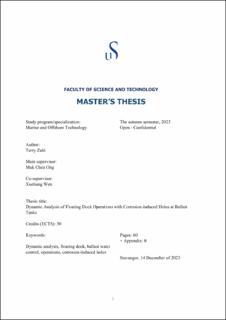| dc.description.abstract | The corrosion at the ballast tanks is a concern risk for floating docks that have been in
service for several decades. Corrosion events can result in severe accidents and huge economic
costs. To migrate the corrosion risk, the dynamic response of a floating dock under corrosion-induced
accidents are studied using a numerical method. The numerical model is proposed to
calculate the dynamic responses of the floating dock during operations. It includes a six-degree-of freedom
(6-DOF) model, a hydrostatic force model, a hydrodynamic force model, a hydraulic
model, and a modified P-controller. The hydraulic model is proposed to model the flow through the
valves and pumps as well as the corrosion-induced holes. The investigated floating dock is
equipped with 18 ballast tanks, which are exposed to corrosion due to the seawater. The influence
of the position and the diameter of the corrosion-induced holes on the stability and the dynamic
behavior of the floating dock at its work position and during the ballasting and de-ballasting
operation are studied numerically using the proposed model. For the corrosion-induced ballasting
of the floating dock at its working position, the maximum pitch and roll angles are 0.42 degrees
and 2.04 degrees respectively when there are one or two holes located at different tanks. For the
automatic ballasting with corrosion-induced holes, the maximum roll and pitch angles during the
operations are found to be proportional to hole diameters. With two 300 mm-diameter corrosion-induced
holes at different ballast tanks, the present modified P-controller is able to regulate the floating
dock's pitch and roll angles within very small ranges. For the automatic de-ballasting with
corrosion-induced holes with a diameter of 300mm, the presence of automatic ballast control
couldn’t keep all cases within a safe margin because some special locations of the corrosion-induced
holes cause large trim and roll moments. This analysis can emphasize the potential hazards of
the corrosion-induced holes and presents an opportunity for the maritime sector to enhance safety,
operational efficiency, and environmental responsibility. | |
